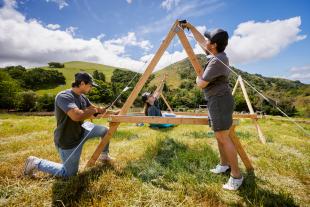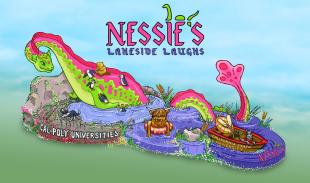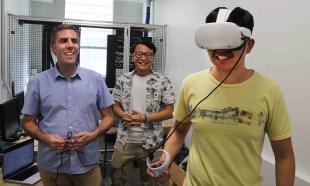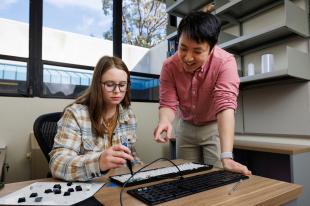Behind ‘Best in the West’: How Cal Poly Has Evolved in the Last Three Decades

Editor's note: This article is from 2022. Click here to read about Cal Poly's most recent Best in the West ranking.
Aerial photo by Steve Proehl
For 30 years in a row, Cal Poly has been named Best in the West among public, master’s-level universities by U.S. News and World Report’s annual Best Colleges guidebook.
The university has also taken the No. 1 spot on the guidebook’s list of Most Innovative Schools in the West since 2018, a ranking that recognizes forward-thinking improvements in curriculum, faculty, students, campus life, technology and facilities.
Rankings are often points of pride in higher education, convenient markers of success and notoriety. But the last 30 years at Cal Poly deserve a deeper look. The win streaks coincide with some of Cal Poly’s most revolutionary growth in its 120-year history. Since the early 1990s, total applications nearly tripled, major academic programs evolved rapidly, and modernized campus facilities took shape. Through it all, Cal Poly’s commitment to its Learn by Doing philosophy has only strengthened, breeding more learning opportunities that position graduates for the future.
Get to know a few ways campus has changed in the last 30 years.
Academics
In the early 1990s, Cal Poly reorganized its academic units and schools into six colleges present today. Several new degree programs have emerged while centers of excellence bolstered academic research and industry partnerships in some of California’s most vibrant industries
Degree Programs
The School of Education (SOE), with programs tracing back nearly a century, changed shape in the last few decades. In the early years, teacher education was a department located in different schools and colleges on campus. Teacher education was reorganized as the University Center for Teacher Education in 1990, renamed the College of Education in 2004, and became the SOE housed in the College of Science and Mathematics in July 2009.
The Wine and Viticulture bachelor’s degree launched in 2006. The distinctive interdisciplinary program is one of the largest in the country, preparing students for careers in the complex 21st century wine business environment.
The M.S. Fire Protection Engineering program launched in 2010. The program, one of three in the nation and the only one on the West coast, analyzes how buildings are used, how fires start, how fires grow, and how fire and smoke affect people, buildings and property.
The Liberal Arts and Engineering Studies bachelor’s degree became a permanent major in 2012. A collaboration between the colleges of Engineering and Liberal Arts, the program prepares students for a wide range of careers in professional fields that combine skills and interests in engineering, the arts, technology and culture.
Cal Poly’s M.S. Business Analytics program launched in 2016, positioned at the crossroads of statistical modeling, big data management, and actionable business insights. The centerpiece of the curriculum is a consulting project with industry clients.
In 2016, the humanities program was renamed interdisciplinary studies in liberal arts (ISLA) to reflect the interconnections of contemporary issues and their solutions. The transfer-only program was then reorganized into a new department in 2019, allowing first-year students to apply.
Centers
The Cal Poly Strawberry Center formed in 2013 in partnership with the California Strawberry Commission to increase the sustainability of California’s strawberry industry. More than 100 students have had Learn by Doing experiences through internships, work experience, senior projects and master’s theses through the center’s work.
The California Cybersecurity Institute was founded in 2015. It brings together the tech community, government agencies, and educational institutions to address the significant shortage of cybersecurity professionals in the United States, which represents a national security crisis.
Open to all students, the Center for Innovation and Entrepreneurship has launched more than 120 companies since 2010, creating over 1,000 jobs, raising more than $250 million, and driving economic development. The center hosts a continuum of resources, including HotHouse spaces in Downtown San Luis Obispo, which also houses the Small Business Development Center and coworking space for local entrepreneurs.
Learn by Doing Programs
New inventions, partnerships and competitions gave birth to more programs that have put students’ skills to use solving complex challenges.
In 1999, the CubeSat concept and satellite deployment system was developed by retired aerospace professor Jordi Puig-Suari and Stanford astronautics professor Bob Twiggs. Cal Poly’s first two CubeSats launched from Kazakhstan on July 26, 2006, but were destroyed when the rocket crashed. The students’ second pair successfully made it to orbit from the same launch site the following April. On Jan. 17, 2021, Cal Poly’s 12th satellite launched aboard a Virgin Orbit rocket.
Students in the PolySat Lab have assisted in scores of other launches, with testing and launch preparations, and later serving as a ground station for the satellites using antennas placed on the roof of Engineering IV. These include the Planetary Society’s two LightSail missions (2015 and 2019) that brought Bill Nye the Science Guy to campus and proved a solar sail can propel a three-unit CubeSat into a higher orbit. They also assisted with a pair of Mars-bound six-unit CubeSats that accompanied NASA’s InSight Mars lander in a launch from Vandenberg Space Force Base in 2018.
Students have also joined forces across colleges to complete in national competitions. Engineers on the Concrete Canoe team have designed, produced and raced creative vessels made of concrete. In 2022, the team won a history-making sixth championship, adding to titles earned in 2010, 2011, 2012, 2017 and 2018.
An interdisciplinary team of students and faculty across several colleges, including architecture and architectural engineering students, designed and constructed a solar house as part of the annual Solar Decathlon, a U.S. Department of Energy/National Renewable Energy Laboratory competition. The team placed third in the nation in 2005 and 2015, gaining valuable hands-on experience while designing and building a solar-powered house that is affordable, innovative and highly energy efficient.
In the Orfalea College of Business, many hands-on projects serve real clients. For 20 years, finance students in the Student Managed Portfolio Project have managed up to $1 million of Cal Poly Corporation funds while navigating the ups and downs of the stock market. The college has also hosted Volunteer Income Tax Assistance clinics on campus since 1992. In the last decade, student accountants have helped prepare more than 7,000 tax returns. Cal Poly’s Low-Income Taxpayer Clinic, established in 2010, is one of a dozen programs in California that assist low-income and English as a second language taxpayers resolve their issues with the IRS. Student have assisted more than 1,000 clients reduce tax liabilities by $4.1 million in 12 years.
In the College of Liberal Arts, the Journalism Department became the first in the CSU system in 2013 to launch an integrated, digital-first, student-run news organization as part of its journalism curriculum. Mustang Media Group (MMG) connected students in print, broadcast and digital news to create a full-circle, independent media organization. Public relations students join journalism students in many aspects of MMG, such as community engagement and marketing.
Equity and Inclusion
The university has made important strides to enhance a welcoming and inclusive campus environment for all Mustangs.
PolyCultural Weekend took shape in 2004 thanks to the ingenuity of student club leaders. The event now welcomes hundreds of high school students from different backgrounds who are considering Cal Poly for a weekend of bonding on campus every spring.
Cal Poly Scholars was created in 2012 to support high achieving students from California schools who come from low-income backgrounds with financial, academic and community resources. The Cal Poly Opportunity Fee, adopted in 2018, boosted funding for the programs.
Cal Poly has led a series of cluster hires, concentrated efforts to recruit and retain faculty who leverage inclusive teaching strategies, as part of the campus’ effort to institutionalize equity. Hires in 2017, 2019 and 2022 have welcomed 30 new faculty members, many of whom have created new course offerings.
Student Diversity and Belonging (SDAB) has established a spectrum of resources and centers to help students feel supported throughout their Cal Poly experience, including the Black Academic Excellence Center, the Native and Indigenous Cultural Center, the Dream Center, the Multicultural Center, the Gender Equity Center, the Men and Masculinities Program, and LGBTQ Campus Life (also known as PRIDE), among other programs. This fall, SDAB plans to open the Latinx Center.
Facilities
Some of the most visible changes to Cal Poly have been the evolution of campus buildings, living spaces and research facilities in San Luis Obispo and beyond. The university has leveraged philanthropic dollars and public-private partnerships to bolster a residential campus that can house roughly 8,000 students and support campus life 24-7.
Swanton Pacific Ranch, a 3,200-acre property in Santa Cruz County, was donated in 1993 by the late Al Smith. Faculty, graduate students and undergraduates actively pursue research opportunities, using the forest, range, and watershed resources within the ranch. Swanton is using more than $20 million in state and grant funds to recover after a wildfire destroyed much of the ranch’s infrastructure in 2020.
The Performing Arts Center opened in 1996 as a unique collaboration between the City of San Luis Obispo, Cal Poly and private donors. The PAC is comprised of several venues, including the 1,286-seat Harold Miossi Hall, the 498-seat Alex & Faye Spanos Theatre, the 180-seat classroom Philips Hall, and the multi-purpose Pavilion, which holds up to 400 people.
The College of Engineering facilities now anchor the northwest corner of campus with more than 180,000 square feet of learning space. The Advanced Technology Laboratories opened in 1999 as the first academic facility on campus built solely with private funding. It houses PolySat’s cleanroom for the CubeSat program and includes a large assembly room for gatherings and presentations. The Engineering III Complex (Bldg. 41) opened over three years starting in 2002 with the Grant M. Brown Engineering Building and the Baldwin and Mary Reinhold Aerospace Engineering Laboratory. The Aero Propulsion Lab opened to students in time in 2005. The Engineering Plaza is flanked by the Bonderson Engineering Projects Center, which opened the following September, and the three-story, block-long Engineering IV that was completed Jan. 1, 2007.
The Cal Poly Pier, built in 1984 by Unocal Corp. to facilitate oil transport on the West Coast, was donated to the university in 2001 and converted into a marine research facility. At 3,000 feet long, it provides students, faculty and researchers with unrivaled access to the marine environment of the Central Coast and is home to the Center for Coastal Marine Sciences.
Campus’ capacity for housing has nearly quadrupled in the last 20 years. Cal Poly introduced the Cerro Vista apartments for second-year students in the fall of 2003. The community houses more than 800 students and was the first housing development on campus in 25 years. In 2008, the first phase of Poly Canyon Village opened, which now houses 2,600 more students on the north end of campus. In 2018, the yakʔitʸutʸu housing community opened along Grand Avenue, replacing a parking lot with a community for 1,475 students. The newest development was named in honor of and in partnership with the Northern Chumash, the Indigenous Peoples of San Luis Obispo County.
Nearly all of Cal Poly Athletics’ facilities and venues have been established or have seen major upgrades since the early 1990s. Bob Jansen Field, the home of Cal Poly Softball opened in 2001; the Mustang Tennis Complex opened in 2005; the 22,000-seat Alex G. Spanos Stadium debuted in 2006; and the Anderson Aquatics Center made a splash in 2009. Most recently, Mustang Baseball constructed a new clubhouse, the Miller and Capriotti Athletics Complex saw major upgrades for the Track and Field programs, and the Swanson Beach Volleyball Complex was built next to Mott Gym. Recreational sports got a boost with renovations to the Sports Complex and the turfed Doerr Family Field.
The Construction Innovations Center and Simpson Strong-Tie Materials Demonstration Laboratory, completed in 2008 and 2010, respectively, added about 56,000 square feet of space for interactive learning with state-of the-art technology.
The Warren J. Baker Center for Science and Mathematics opened for classes in fall 2013 with the goal of hosting every Cal Poly student for at least some of their coursework. The six-story, 189,000-square-foot building is the second largest on campus, next to Kennedy Library. It holds classrooms, faculty and department offices, instructional and research facilities for multiple departments. It’s also home to The Center for Applications in Biotechnology, The Kenneth N. Edwards Western Coatings Technology Center, and the Institute for Advanced Technology and Public Policy. A bench featuring a sculpture of Albert Einstein greets visitors at its south entrance and a living periodic table lights up study space on the second floor.
The new Vista Grande dining complex opened in 2020 to offer Mustangs seven new dining venues and a neighborhood market. The three-story facility is LEED gold certified and features new options for allergen-free, vegetarian and vegan fare.
The $4.9-million Plant Conservatory, which opened last year, features three growing areas —tropical, desert and cool tropical — a propagation greenhouse and research greenhouses. Outside, there is 1,000 square feet of lath-shaded area.
The William and Linda Frost Center for Research and Innovation, a cross-disciplinary 105,000-square foot facility, is slated to open soon with state-of-the-art lab and classroom space supporting multiple colleges.
Want more Learn by Doing stories in your life? Sign up for our monthly newsletter, the Cal Poly News Recap!




















